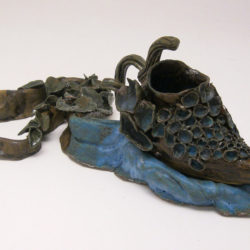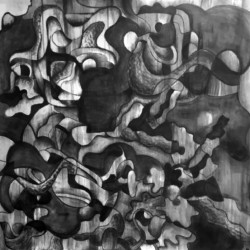Analyses
Remedial Poetry
By Carter Piagentini ’25
I’m often haunted by the feeling of being called out of my 2nd-grade class during the middle of a lesson to go practice my reading skills every week. An old lady would quietly peek her head through the door, whisper something to the teacher, and then I would find myself being led down the hall to a different room.
See MoreThe Lucky One
By Bria Holthe ’23
We exist in an environment under severe threat. We are swiftly approaching the point of no return in the climate crisis. Eventually, we will be forced to figure out not how to stop it, but how to live through it.
See MoreBeauty and Monstrosity: Race in Early English Literature
By Quinn Deahl ’23
The medieval and renaissance periods of British history mark the point in time when England began developing its national identity. This evolution coincides with the increasing contact between the English and different national groups which allowed them to truly distinguish themselves. Early English literature reflects these developments and the subsequent attitudes that the English began to advance about themselves and their perceived others.
See MoreQueerness and Queens: Queer Analysis of RuPaul’s Drag Race Season 14
By Gannon Oberhauser ’23
RuPaul’s Drag Race is a reality competition show where the best queens from across the country compete for a grand prize of $100,000. The queens participate in challenges testing them in areas of fashion, design, comedy, and acting.
See MoreRobert Henri and the Ideal Woman: An Analysis of Ballet Girl in White
By Fynn Wadsworth ’25
In the early 1900s, artists were still largely defining who and what was worth documenting and drawing attention to. The upper classes still dominated the art world and while many artists were frequently depicting the lower classes in their work, they were still largely stigmatized subjects.
See MoreNo Se Espera Que Seamos Buenas En Física
By Katie Wang
“No se espera que seamos buenas en física” es un poema que hace un comentario sobre las expectativas de la sociedad sobre las mujeres. Este poema fue escrito al estilo de Alfonsina Storni, una importante escritora de la literatura hispanoamericana.
See MoreBlack Panther, Whitewashing: Colonialism and Neocolonialism Ideals in Marvel’s Black Panther
By Matthew Dickinson
In recent years, the Marvel Cinematic Universe (MCU) has provided some of the most popular and influential superhero movies. Starting with Iron Man in 2008, the MCU has generated massive revenue while also pushing the boundaries of the oft-maligned superhero genre and kept up with DC Comics, their main competitors. One such revolutionary film is Black Panther, which was released in 2018.
See MoreA Family Experience?: Familial Roles and Their Impact on Illness Experiences in The Farewell
By Marin Harrington
In the opening credits of writer-director Lulu Wang’s 2019 film The Farewell, a single phrase appears on the screen: “Based on a true lie.” In one of the film’s first scenes, 30-year-old Billi Wang, the first-generation American daughter of Chinese immigrants, learns that her grandmother, Nai Nai, is dying of Stage IV lung cancer.
See MoreEnvironmental Minimalism and Inspirational Wonder in Paradise Lost
By Emma Chervek
Paradise Lost tells the story of the creation of the universe based on the Biblical account in the book of Genesis, focusing on Adam and Eve’s early life in Eden: earth’s ultimate paradise. This story is influenced by the natural characteristics of its setting and is therefore inseparable from the physical environment in which this story is set.
See MoreThe Realm of Faeries: Queerness and Neurodivergence in Jane Eyre
By Grace Patrick-West
During the Victorian era, interest in faeries began to peak. With the Brontë family connection to Ireland, Charlotte Brontë’s inclusion of faery lore in her novel Jane Eyre is quite useful in understanding her connection to both the time period she lived in and to her Irish lineage.
See MoreBridging Cultural Difference in Albert Camus’s “The Guest”
By Marin Harrington '21
Differences between cultures are frequently the root of conflict, and these types of conflicts are often well-documented. Less discussed are the instances when people unify despite their cultural differences, or, even more profoundly, expand their own worldview by understanding someone else’s cultural perspective.
See MoreRace Perceptions in “Recitatif”
By Allison Stuenkel '20
The short story “Recitatif” by Toni Morrison truly challenged the unconscious stereotypes I did not know I believed.
See MoreBlurred Boundaries: Soldiers/Terrorists, War/Peace
By Barbara Engleheart
In modern societies, violence is typically categorized into justified violence, or violence necessary for “the greater good,” versus violence as evil, criminal and unjustified. There are two constructs for which this differentiation has been naturalized so strongly that we usually would not even consider drawing parallels between them: soldiers and terrorists.
See MoreYoung… Love?
By Madaline Hucks '20
Adolescence is a time when both boys and girls are discovering themselves and interacting with their peers in new ways. First kisses and hand-holding are hallmarks of this time, and one’s first “puppy love” may take over their hormonal and dramatic selves. But what happens when this lovesick admiration goes wrong?
See MoreLiterary Style in Nervous Conditions
By Brandon Rosas '20
Tsitsi Dangarembga writes her debut novel, Nervous Conditions, with a liberatingly dense style. Unlike that of many other African writers, Dangarembga’s periphrastic, prolix prose harkens back more to that of Charles Dickens than to that of Chinua Achebe.
See MoreDionysian and Apollonian Elements in David’s The Tennis Court Oath
By Christian Warner '20
Jacques-Louis David’s Le Serment du Jeu de Paume, or The Tennis Court Oath presents us with a chaotic scene. In this unfinished painting, there are hundreds of people clustered together, seemingly in a frenzy. Yet, there is no physical violence in the painting. Although there is a sense of chaos from the sheer volume of people crammed in the tennis court, there is also a sense of communion—communion in the sense that all the people in the painting are together and regard each other as brothers or allies.
See MoreLast Refuge: The Escape from Violence in Kafka on the Shore
By Bailey Anderson '18
Postmodernist novels famously defy convention and resist unifying theories or ideologies. They lack conclusionary details and the most bizarre occurrences are often left “up in the air.” Even in the novels themselves, readers are sometimes advised against trying to make too much out of the stories they tell.
See MoreLa casa y la identidad en La casa en Mango Street
By Molly Timmerman '18
La Casa en Mango Street de Sandra Cisneros es narrada por una joven chicana llamada Esperanza. Durante la historia, Esperanza tiene doce o trece años y vive en Chicago, en un barrio pobre con muchos otros latinos.
See MoreThe Bohemian Problem: A Sociological and Literary Examination of Willa Cather’s Fraught Relationship with Czech Culture
By K.E. Daft '19
Willa Cather has been hailed, for decades, as an advocate for Bohemian culture.
See MoreMachiavelli’s Politics and A Game of Thrones: The Board Game
By Matthew Wells '18
A Game of Thrones: The Board Game (GOT) is a laudable effort to put in players’ hands the chance to exercise their inner Machiavellian in a (hopefully) nonviolent fashion.
See MoreEl feminismo disimulado en “La indiferencia de Eva” de Soledad Puértolas
By Katie Haffenden '18
En el libro de relatos Una enfermedad moral, publicado en 1982 y escrito por Soledad Puértolas, hay un cuento llamado “La indiferencia de Eva.” Para el lector ocasional es posible que el cuento parezca como si nada significante ocurriera.
See MoreThe Business of Love in The Good Woman of Setzuan
By Bailey Anderson '18
Ask anyone what the most important factor in a successful relationship is, and they will likely tell you it is love. However, even people who love each other face challenges which may jeopardize the relationship.
See MoreRestoration Through Brave Narration
By Peyton Gray '18
In the popular Middle Eastern piece of literature entitled The Thousand and One Nights (The Nights), a frame-tale narrative is used to tell various stories that revolve around King Shahrayar and his relationship with women.
See MoreFlash of Lightning, Sprig of Lilac: Representations of Nature in Whitman’s War Poetry
By Hannah Marcum '18
Aroused and angry, I thought to beat the alarum, and urge relentless war; But soon my fingers fail’d me, my face droop’d, and I resign’d myself. To sit by the wounded and sooth them, or silently watch the dead.
See More


















